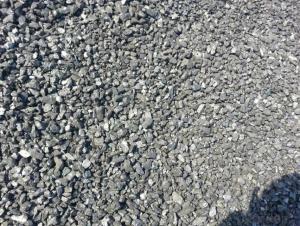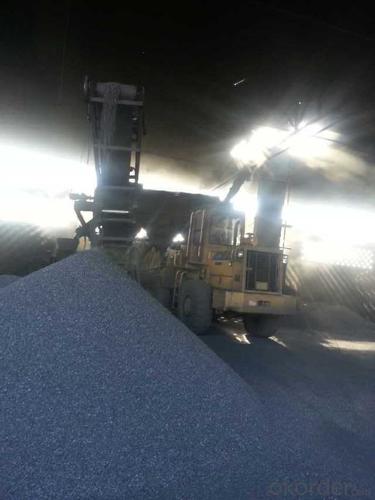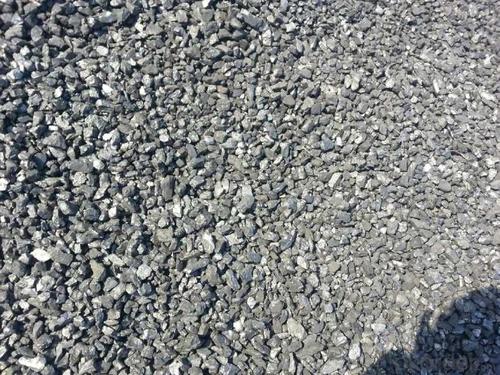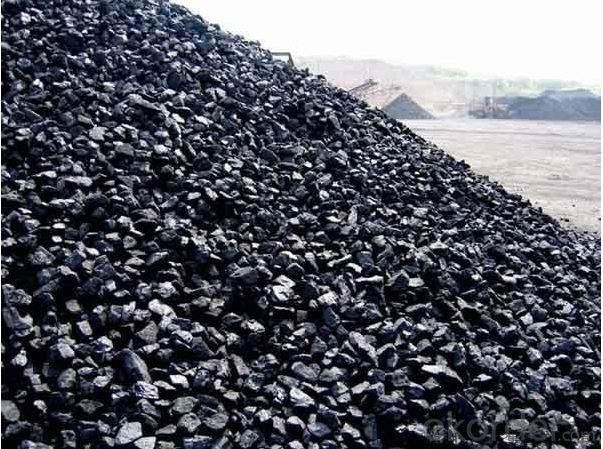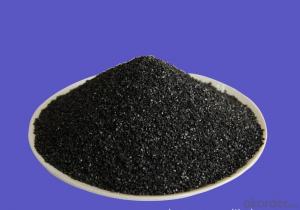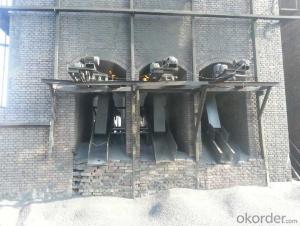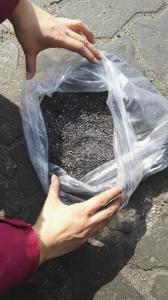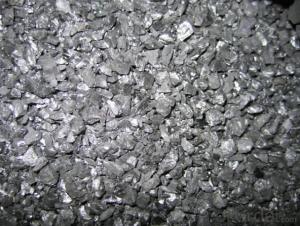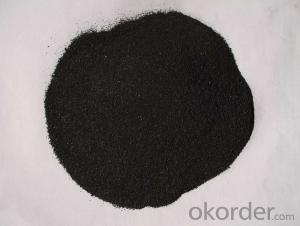Carbon Raiser FC90-95 Calcined Anthracite Coal
- Loading Port:
- Tianjin
- Payment Terms:
- TT OR LC
- Min Order Qty:
- 20 m.t.
- Supply Capability:
- 5000 m.t./month
OKorder Service Pledge
OKorder Financial Service
You Might Also Like
Packaging & Delivery
Carbon Raiser FC90-95 Calcined Anthracite Coal
25kgs/50kgs/1ton per bag or as buyer's request
Specifications
Carbon Raiser FC90-95 Calcined Anthracite Coal
Calcined Anthracite
Fixed carbon: 90%-95%
S: 0.5% max
Size: 0-3. 3-5.3-15 or as request
Carbon Raiser FC90-95 Calcined Anthracite Coal
It used the high quality anthracite as raw materials through high temperature calcined at over 2000 by the DC electric calciner with results in eliminating the moisture and volatile matter from anthracite efficiently, improving the density and the electric conductivity and strengthening the mechanical strength and anti-oxidation. It has good characteristics with low ash, low resistvity, low sulphur, high carbon and high density. It is the best material for high quality carbon products.
Advantage:
Carbon Raiser FC90-95 Calcined Anthracite Coal
1. strong supply capability
2. fast transportation
3. lower and reasonable price for your reference
4.low sulphur, low ash
5.fixed carbon:95% -90%
6..sulphur:lower than 0.3%
General Feature:
Carbon Raiser FC90-95 Calcined Anthracite Coal
| FC | 95 | 94 | 93 | 92 | 90 |
| ASH | 4 | 5 | 6 | 6.5 | 8.5 |
| V.M. | 1 | 1 | 1 | 1.5 | 1.5 |
| S | 0.3 | 0.3 | 0.3 | 0.35 | 0.35 |
| MOISTURE | 0.5 | 0.5 | 0.5 | 0.5 | 0.5 |
Pictures
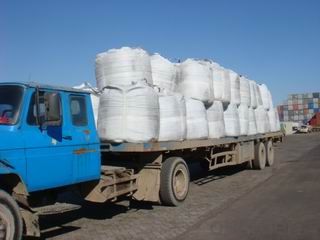
- Q: What are the effects of carbon emissions on the stability of volcanic regions?
- Carbon emissions can potentially have both positive and negative effects on the stability of volcanic regions. On one hand, increased carbon dioxide levels in the atmosphere can contribute to global warming, which in turn may lead to melting of glaciers and ice caps, resulting in a rise in sea level. This rise in sea level can increase the likelihood of volcanic flank collapse, as the added pressure weakens the stability of volcanic slopes. Additionally, global warming can also trigger more frequent and intense rainfall, potentially leading to increased erosion and landslides in volcanic areas. On the other hand, carbon dioxide emissions can also have a stabilizing effect on volcanic regions. The injection of carbon dioxide into volcanic systems can enhance the pressure within magma chambers, promoting magma crystallization and solidification. This process can reduce the likelihood of volcanic eruptions, as the solidified magma acts as a barrier that hinders the movement and release of magma. Overall, the effects of carbon emissions on the stability of volcanic regions are complex and dependent on various factors. It is crucial to continue studying these interactions to better understand the potential consequences and implications for volcanic hazards and the overall stability of volcanic regions.
- Q: What are the properties of activated carbon?
- Activated carbon is a highly porous material with a large surface area that allows it to adsorb or trap a wide range of organic and inorganic impurities from gases and liquids. It has a high adsorption capacity, excellent chemical stability, and is resistant to abrasion. Activated carbon is also known for its ability to remove odors, color, and taste from substances. Moreover, it can be easily regenerated and reused, making it a cost-effective and environmentally friendly solution for various purification processes.
- Q: How does carbon affect the formation of tsunamis?
- The formation of tsunamis is not directly influenced by carbon. Tsunamis primarily occur as a result of underwater earthquakes, volcanic eruptions, or landslides. Carbon, in the form of carbon dioxide (CO2), is a greenhouse gas that contributes to global warming and climate change. Although carbon emissions and the resulting climate change can affect ocean temperatures and sea levels, they do not directly cause tsunamis. However, it is important to consider that climate change can indirectly impact the intensity and frequency of natural disasters, including tsunamis, by affecting oceanic and atmospheric conditions. The rising sea levels caused by melting glaciers and polar ice can potentially increase the destructive power of tsunamis by enabling them to reach further inland. Moreover, climate change can influence the occurrence and strength of earthquakes and volcanic activity, which are the main triggers of tsunamis. Therefore, even though carbon emissions do not directly influence the formation of tsunamis, their impact on climate change can indirectly affect the factors that contribute to the development and severity of tsunamis.
- Q: What are the effects of carbon emissions on the Arctic ecosystem?
- The Arctic ecosystem is significantly impacted by carbon emissions, primarily due to global warming. The release of carbon dioxide and other greenhouse gases into the atmosphere traps heat, leading to increased temperatures worldwide. However, the Arctic is particularly susceptible to these effects because of its unique characteristics. One of the most noteworthy consequences of carbon emissions on the Arctic ecosystem is the rapid melting of ice. Increasing temperatures cause glaciers and ice sheets to decrease in size, resulting in the loss of habitat for ice-dependent species like polar bears, walruses, and seals. These animals not only depend on the ice for resting and breeding but also for hunting and finding food. The reduction of their natural habitat has led to a decline in their populations, impacting the delicate balance of the Arctic food chain. Moreover, the melting of ice leads to rising sea levels, which can have cascading effects on coastal areas. Many Arctic communities, including indigenous peoples, are located near the coast and rely on the sea for their livelihoods. The increase in erosion, flooding, and storm surges due to rising sea levels pose a threat to their homes, infrastructure, and traditional ways of life. Furthermore, carbon emissions contribute to ocean acidification, a process in which excess carbon dioxide absorption by seawater lowers its pH level. This acidification has detrimental effects on marine organisms such as shellfish, corals, and plankton, which struggle to build and maintain their calcium carbonate structures. These organisms serve as essential food sources for various Arctic species, including fish, seabirds, and marine mammals. The decline in their populations disrupts the intricate web of life in the Arctic and can have far-reaching consequences. Climate change caused by carbon emissions also disrupts the timing and patterns of seasonal events, such as plant growth, bird migration, and the availability of food resources. This mismatch can have severe consequences for species that rely on specific timing for reproduction, migration, and survival. In summary, the effects of carbon emissions on the Arctic ecosystem are significant and extensive. The loss of sea ice, rising sea levels, ocean acidification, and disrupted ecological processes all contribute to the vulnerability of Arctic species and communities. Urgent action to reduce carbon emissions, mitigate climate change, and protect this fragile ecosystem is crucial for the long-term preservation of the Arctic.
- Q: What is carbon offsetting in the food industry?
- The concept of carbon offsetting within the food industry involves the act of counteracting or compensating for the greenhouse gas emissions associated with the processes of food production and distribution. It serves as a means for food companies to take responsibility for their carbon footprint and make a contribution towards global endeavors in mitigating climate change. Significant contributions to greenhouse gas emissions originate from activities related to food production and distribution, primarily including deforestation, alterations in land use, energy consumption, and transportation. Through carbon offsetting, food industry companies are able to invest in projects or initiatives aimed at reducing or eliminating an equal quantity of carbon dioxide from the atmosphere, effectively balancing out their own emissions. Within the food industry, there exist various approaches to carbon offsetting. A frequently employed method involves investment in renewable energy projects, such as wind farms or solar power installations, which counterbalance emissions arising from energy consumption within food processing facilities or during transportation. Another method involves providing support for projects aimed at promoting sustainable agricultural practices, such as reforestation or afforestation endeavors, which contribute to the capture of carbon dioxide from the atmosphere. The practice of carbon offsetting within the food industry also extends to the realm of supply chain management. Companies are able to collaborate with their suppliers in order to implement more sustainable farming practices, minimize waste, and optimize transportation routes, all with the intention of reducing emissions. By engaging with farmers, producers, and distributors, food companies can collectively strive towards reducing their overall carbon footprint and attaining carbon neutrality. It should be recognized that carbon offsetting is not intended to serve as a substitute for reducing emissions at their source. Rather, it should be seen as a supplementary measure, supporting the transition towards more sustainable and low-carbon practices within the food industry. Through offsetting their emissions, food companies are able to demonstrate their commitment to environmental stewardship and contribute to the global fight against climate change.
- Q: What are the effects of carbon emissions on the stability of coastal ecosystems?
- Carbon emissions have significant negative effects on the stability of coastal ecosystems. The increased concentration of carbon dioxide in the atmosphere leads to ocean acidification, which disrupts the delicate balance of marine ecosystems. This acidity affects the growth and development of various organisms such as corals, shellfish, and other calcifying organisms, jeopardizing the health of coral reefs and shellfish populations. Additionally, rising sea levels, a result of climate change caused by carbon emissions, threaten coastal habitats, including wetlands and mangroves, which serve as critical nurseries and protective buffers against storms. Overall, carbon emissions contribute to the degradation and vulnerability of coastal ecosystems, compromising their stability and the services they provide to both marine life and human communities.
- Q: Stability, primary carbon, two carbon, three carbon, four carbon
- From a variety of hydrogen is substituted alkyl free radicals generated in terms of difficulty order can have free radicals for the formation of tertiary carbon free radical secondary carbon free primary carbon free radicals. Alkyl radicals generated methyl easily, can be explained from two aspects: (1) different required to form free radicals when the fracture of C-H the energy, the (CH3) 3C-H fracture, the energy required for the smallest, most easily generated.
- Q: What is carbon neutral agriculture?
- Carbon neutral agriculture encompasses farming practices that strive to balance the amount of carbon released into the atmosphere with the amount of carbon sequestered or removed. Its objective is to adopt sustainable and environmentally friendly methods that minimize greenhouse gas emissions and promote the absorption of carbon dioxide from the atmosphere. There are several key practices involved in achieving carbon neutrality in agriculture. One of these practices involves reducing the usage of fossil fuels by implementing renewable energy sources, such as solar or wind power, for farm operations. This approach aids in diminishing emissions associated with machinery, equipment, and transportation. Another crucial aspect is the management of soil health and the enhancement of carbon sequestration. This can be accomplished via practices like cover cropping, crop rotation, and conservation tillage, which help augment organic matter in the soil. Consequently, this contributes to the storage of carbon. Furthermore, carbon neutral agriculture advocates for the use of organic fertilizers and natural pest control methods, thereby minimizing the necessity for synthetic chemicals that emit harmful greenhouse gases. Offsetting carbon emissions is another strategy employed in carbon neutral agriculture. This may involve the planting of trees on the farm or in nearby areas to absorb carbon dioxide from the atmosphere. Additionally, it can encompass participation in carbon credit programs, where farmers receive compensation for implementing sustainable practices that reduce emissions. In essence, carbon neutral agriculture adopts a comprehensive approach to minimize the carbon footprint of farming operations. By reducing emissions and maximizing carbon sequestration, it aids in mitigating climate change and promoting a more sustainable agricultural system.
- Q: What are the effects of carbon emissions on the stability of alpine ecosystems?
- The stability of alpine ecosystems is significantly and extensively affected by carbon emissions. Carbon emissions, mainly in the form of carbon dioxide, contribute to the greenhouse effect and subsequent climate change, thereby causing a series of impacts that directly influence the stability of alpine ecosystems. One of the most noticeable consequences is the rise in global temperatures. With increasing temperatures, glaciers and snow caps in alpine regions melt at accelerated rates. This has a profound impact on the availability of freshwater resources since alpine regions often serve as the origin of major rivers and lakes. Decreased water availability not only affects the survival of plant and animal species but also has consequences for human populations that rely on these water sources for agriculture, drinking water, and hydropower generation. Another result of carbon emissions is the alteration of precipitation patterns. Climate change disrupts the balance between rainfall and snowfall in alpine ecosystems, leading to more frequent and intense droughts or rainfall events. Such changes in precipitation patterns can result in soil erosion, landslides, and the overall instability of alpine terrain. This poses a threat to the survival of alpine flora and fauna, as well as the loss of crucial habitats and biodiversity. Furthermore, carbon emissions contribute to the acidification of alpine lakes and rivers. Increased carbon dioxide in the atmosphere dissolves in water bodies, forming carbonic acid. This acidification negatively affects aquatic organisms, such as fish and amphibians, impairing their reproductive abilities, altering their behavior, and even causing mortality. It also disrupts the delicate balance of alpine freshwater ecosystems, leading to a decrease in species diversity and ecological resilience. Lastly, carbon emissions can indirectly impact alpine ecosystems through the expansion of invasive species. Climate change creates favorable conditions for the migration of non-native plant and animal species to higher elevations. These invasive species can outcompete native flora and fauna, disrupt ecological interactions, and ultimately lead to the displacement or extinction of native species. This disrupts the natural balance of alpine ecosystems and compromises their stability. In conclusion, the stability of alpine ecosystems is profoundly affected by carbon emissions. These emissions contribute to the melting of glaciers, alteration of precipitation patterns, acidification of water bodies, and the spread of invasive species. These impacts disrupt the balance of alpine ecosystems, leading to the loss of biodiversity, degradation of habitats, and reduced availability of freshwater resources. Urgent action to mitigate carbon emissions is crucial to preserve the stability and functioning of these fragile ecosystems.
- Q: How does carbon impact the prevalence of heatwaves?
- Carbon impacts the prevalence of heatwaves by contributing to the greenhouse effect. When carbon dioxide and other greenhouse gases are released into the atmosphere, they trap heat from the sun, leading to a rise in global temperatures. This increase in temperature makes heatwaves more frequent, intense, and longer-lasting, posing significant risks to human health, ecosystems, and infrastructure.
Send your message to us
Carbon Raiser FC90-95 Calcined Anthracite Coal
- Loading Port:
- Tianjin
- Payment Terms:
- TT OR LC
- Min Order Qty:
- 20 m.t.
- Supply Capability:
- 5000 m.t./month
OKorder Service Pledge
OKorder Financial Service
Similar products
Hot products
Hot Searches
Related keywords

